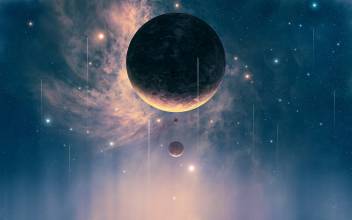Supernovae occur when a giant star, one much bigger than our own Sun, collapses and then spectacularly explodes, releasing in an instant the energy of a hundred billion suns, burning for a time brighter than all the stars in its galaxy. "It's like a trillion hydrogen bombs going off at once," says Evans. If a supernova explosion happened within five hundred light-years of us, we would be goners, according to Evans—"it would wreck the show," as he cheerfully puts it.
當一顆巨大的恒星--一顆比我們的太陽還大的恒星--坍縮的時候,它接著會壯觀地爆炸,剎那間釋放出1000億顆太陽的能量,一時之間比自己星系里所有的恒星的亮度加起來還要明亮。于是,一顆超新星誕生了。"這景象猶如突然之間引爆了1萬億枚氫彈。"埃文斯說。他還說,要是超新星爆炸發(fā)生在離我們只有500光年遠的地方,我們就會完蛋--"徹底把鍋砸了。"他樂呵呵地說。

But the universe is vast, and supernovae are normally much too far away to harm us. In fact, most are so unimaginably distant that their light reaches us as no more than the faintest twinkle. For the month or so that they are visible, all that distinguishes them from the other stars in the sky is that they occupy a point of space that wasn't filled before. It is these anomalous, very occasional pricks in the crowded dome of the night sky that the Reverend Evans finds.
但是,宇宙是浩瀚的,超新星通常離我們很遠很遠,不會對我們造成傷害。事實上,大多數(shù)遠得難以想像,它們的光傳到我們這里時不過是淡淡的一閃。有一個月左右的時間,它們可以看得見。它們與天空里別的恒星的惟一不同之處是,它們占領了一點兒以前空無一物的空間。埃文斯在夜間滿天星斗的蒼穹里尋找的,就是這種很不尋常、非常偶然發(fā)生的閃光。
To understand what a feat this is, imagine a standard dining room table covered in a black tablecloth and someone throwing a handful of salt across it. The scattered grains can be thought of as a galaxy. Now imagine fifteen hundred more tables like the first one—enough to fill a Wal-Mart parking lot, say, or to make a single line two miles long—each with a random array of salt across it. Now add one grain of salt to any table and let Bob Evans walk among them. At a glance he will spot it. That grain of salt is the supernova.
為了理解這是一種多么高超的本事,我們來想像一下,在一張標準的餐桌上鋪一塊黑桌布,然后撒上一把鹽。我們把撒開的鹽粒比做一個星系。現(xiàn)在,我們來想像一下,再增加1500張這樣的餐桌--足以形成3公里長的一條直線--每一張餐桌上都隨意撒上一把鹽。現(xiàn)在,在任意一張餐桌上再加一粒鹽,讓羅伯特·埃文斯在中間行走。他一眼就看到了那粒鹽。那粒鹽就是超新星。











